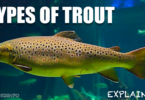When we think of sharks, the first images that typically come to mind are great white sharks, hammerheads, or even the infamous elephant shark These top marine predators are known for having a fearsome reputation with their remarkable strength. But not all sharks fit this aggressive view, the horn shark stands out as a distinctive and often overlooked species. This submissive and small-bodied shark has a unique look and character fascinating variety that makes it an interesting subject to study. This article will uncover the world of horn sharks, and examine their physical features, behavior, and conservation status.
What is the Taxonomic Classification of Horn Fish?
Heterodontus francisci, commonly known as the horn shark, belongs to the following taxonomic classification:
- Kingdom: Animalia
- Phylum: Chordata
- Class: Chondrichthyes
- Order: Heterodontiformes
- Family: Heterodontidae
- Genus: Heterodontus
- Species: francisci
What is the Habitat and Range of Horn Sharks?
Horn sharks inhabit mainly the shallow waters and rocky coastal areas of the Pacific Ocean. Its range includes the warm tropical waters of the Gulf of California as well as the tropical seas off the Californian coast. They like shallow water, often between 40 and 150 feet deep, and are frequently spotted close to rock outcrops and kelp forests.
What is the Physical Appearance of Horn Sharks?
These small and slowly moving sharks have a robust body, remarkable hornbill-like features, and spines on the backs of their wings. The horn shark’s spines are not dangerously sharp. They have strong horn-like features which combined with the unique color make for a memorable, memorable, and charismatic species for those fortunate enough to encounter it.
What is the Feeding Habitat of Horn Sharks?
Horn sharks are opportunistic predators whose main diet consists of mollusks, crustaceans, and small fish. Their teeth prefer to chew and crush rather than tear, indicating a preference for hardy prey such as crabs and sea urchins.
Horned sharks use a unique strategy to catch their prey. They use their muscular bodies to anchor themselves in hard crevices or rocks on the seafloor. This stealth approach allows them to wait for unsuspecting victims to get too close. When the opportunity presents itself, the shark rushes forward to crush its prey with its powerful jaws. Their strong, thin teeth are well suited to cracking the shells of their favorite foods.
What Reproduction Pattern and Lifecycle Do Horn Sharks Adopt?
Breeding is an interesting event in horned sharks because they are oviparous, which means they lay eggs rather than live young. A female horn shark will lay two long spiral clusters of eggs at a time, which she places with her beak under a rock. These tissues protect the developing embryos from predators and provide a niche den for growth.
The incubation period for horn shark eggs can be very long, ranging from 6 to 10 months depending on water temperature and other environmental factors. Once the baby sharks are released from the egg incubator, they begin their journey as free creatures in the depths. Horned sharks have relatively long life spans for their size, from about 12 years to about 25 to 30 years in the wild. During this time, they breed, which helps to maintain their species.
What is the Conservation Rank of Horn Sharks?
Despite their unique characteristics and striking physiology, horn sharks are listed Data deficient by IUCN because they face many threats that have raised concerns about their conservation. Like numerous marine creatures, their populations are seriously threatened by human activities like habitat destruction brought on by coastal development and pollution. To safeguard these amazing species and keep their habitats healthy, conservation activities are crucial to carry out.
Conclusion
With its distinctive shape and fascinating morphology, the horn shark is a true gem of the Pacific Ocean. Despite its small size, this unassuming horn shark has captured the hearts and curiosity of marine enthusiasts and observers. Its sedentary lifestyle, special diet, and unique breeding patterns are a fascinating study of scientific learning and a reminder of the intricate web of life that thrives beneath the wave. Conserving their habitats and understanding their ecosystems is an important step to secure these remarkable creatures for future generations.







